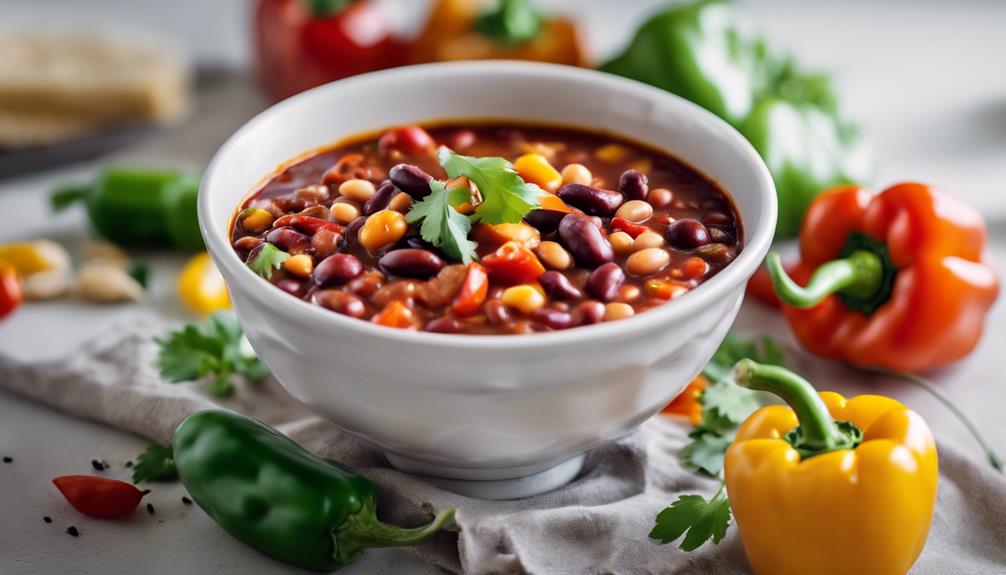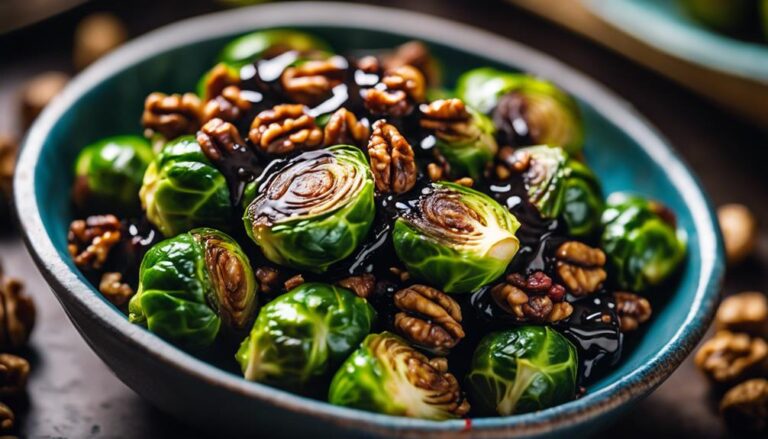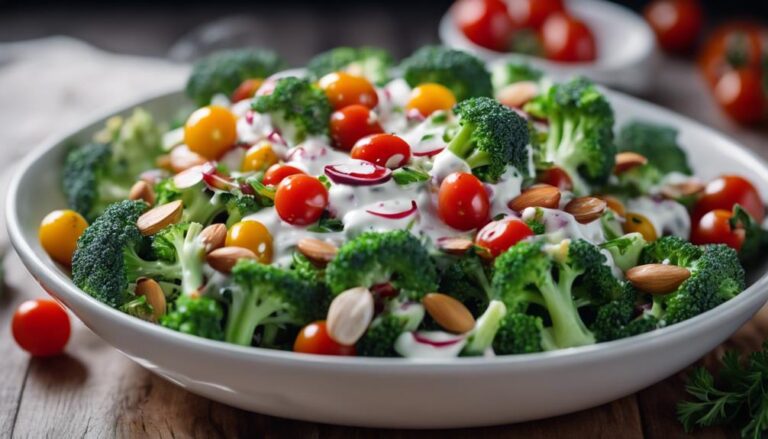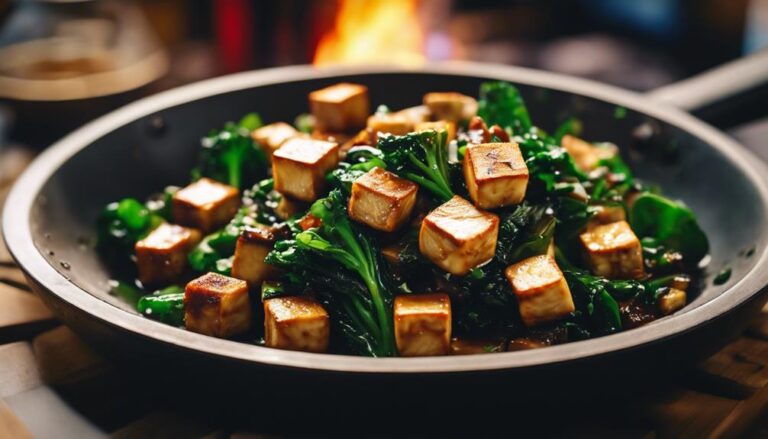Vegetarian Chili With Sous Vide Spiced Beans
Create a flavorful twist on vegetarian chili by infusing sous vide spiced beans. This method adds depth to your dish. Start by preparing traditional chili components like beans, vegetables, and spices. Utilize sous vide for spice infusion, vacuum-sealing for ideal flavors. Experiment with ingredient substitutions, cocoa powder for richness, and roasted vegetables for intensified flavors. Delight in a mix of textures and customize with different beans. Play with contrasts in mouthfeel using varied bean choices. Elevate your chili game with enhanced taste and texture. Uncover culinary secrets to boost your vegetarian chili experience.
What You Will Learn Here
- Sous vide infuses beans with rich flavors for vegetarian chili.
- Spiced beans add depth and complexity to the dish.
- Precision in sous vide cooking ensures perfectly seasoned beans.
- Sous vide technique enhances texture and taste of the beans.
- Spiced beans create a flavorful base for a hearty vegetarian chili.
Chili's Origins
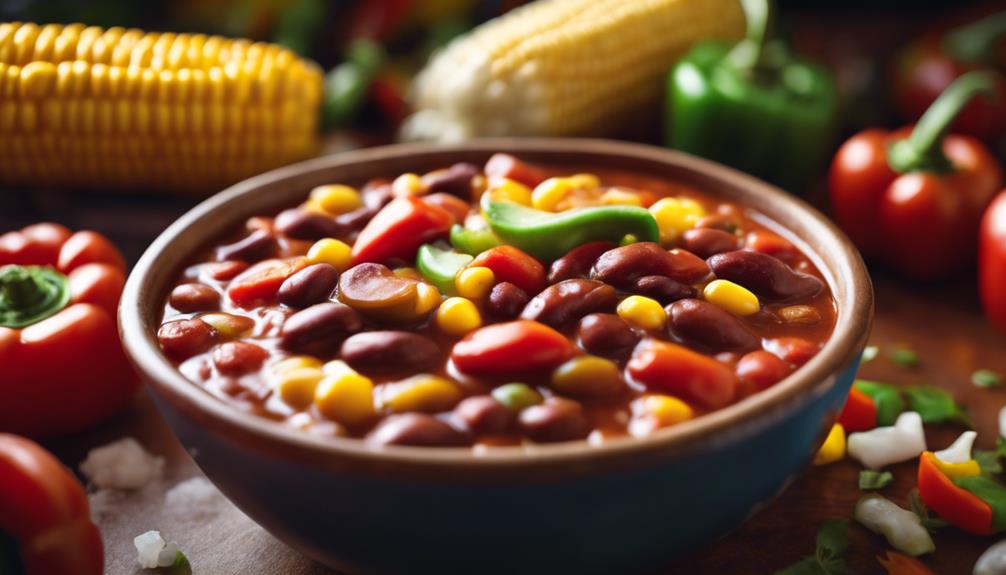
Chili has a rich history that dates back centuries, originating in regions like Texas and Mexico.
Over time, this dish has evolved, with various ingredients and cooking methods influencing its preparation.
The cultural impact of chili has been significant, with many communities embracing it as a beloved culinary tradition.
Chili's Historical Roots
With a rich history dating back centuries, the origins of chili can be traced to various regions across the globe. Chili's global influence and historical significance have made it a beloved dish that has evolved over time. From its roots in indigenous communities in the Americas to its spread across continents through trade and colonization, chili has undergone a fascinating culinary journey, blending diverse cultural influences to create unique flavor profiles.
The culinary history of chili reveals how different regions have adapted the dish to suit local tastes and ingredients. The use of spices like cumin, chili peppers, and garlic reflects the fusion of flavors that have shaped chili into the hearty and flavorful stew we enjoy today. Each variation of chili, whether it's Texas-style with beef or vegetarian options like the one presented here, showcases the versatility and adaptability of this iconic dish. As chili continues to be enjoyed worldwide, its historical roots remind us of the rich tapestry of flavors that have contributed to its enduring popularity.
Evolution of Chili
Exploring the historical trajectory of chili reveals a fascinating evolution rooted in diverse culinary traditions and global influences.
Chili, as it's understood today, has undergone significant evolutionary adaptations over the centuries. Originally, chili con carne, a spicy stew with meat and chilies, was believed to have originated in the American Southwest during the 19th century. However, its roots can be traced back to Indigenous Mexican cuisine, where similar dishes were prepared with local ingredients.
As chili spread across regions and cultures, it underwent various culinary transformations. Different regions began adding their own unique twists, incorporating ingredients like beans, tomatoes, and different types of meat. This led to the creation of a wide array of chili variations, each reflecting the tastes and preferences of the local population.
Through these culinary exchanges and adaptations, chili has become a versatile dish enjoyed worldwide. Its evolution showcases how a simple stew can transform into a beloved comfort food, cherished for its rich flavors and cultural significance.
Cultural Impact of Chili
How did the cultural influences shape the origins of this beloved dish known as chili?
Chili, a flavorful stew-like dish, traces its roots back to the indigenous peoples of the Americas. Native American tribes, such as the Aztecs and Incas, are believed to have been among the first to combine chili peppers with meat to create a spicy concoction. The Spanish later introduced ingredients like cumin and garlic to the mix, influencing the evolution of chili into the dish as it stands today.
Global chili variations have since emerged, with each region adding its own unique twist to the classic recipe. In Texas, chili con carne reigns supreme, while vegetarian versions have gained popularity in other parts of the world. This diversity reflects the dish's adaptability and its ability to transcend cultural boundaries.
The impact of chili on modern cuisine is undeniable. Its bold flavors and versatile nature have inspired chefs worldwide to experiment with new ingredients and techniques. Whether enjoyed as a comforting bowl of warmth on a chilly day or as a topping for hot dogs and burgers, chili continues to hold a special place in the hearts of food lovers everywhere.
Basic Chili Components
Consider incorporating a variety of beans to enhance the flavor and texture of your vegetarian chili. When preparing your chili, keep in mind these basic components:
- Beans: Experiment with different types such as kidney beans, black beans, pinto beans, or chickpeas to add depth and substance to your dish.
- Vegetables: Onions, bell peppers, and tomatoes are classic additions that provide a robust flavor base for your chili.
- Spices: Cumin, chili powder, paprika, and garlic powder can help create a rich and aromatic profile for your vegetarian chili.
- Broth: Whether using vegetable broth or water, the liquid component is crucial for achieving the right consistency and balance of flavors.
- Thickener: Ingredients like tomato paste or cornmeal can help thicken your chili to the desired consistency.
Savory Vegetarian Chili Options
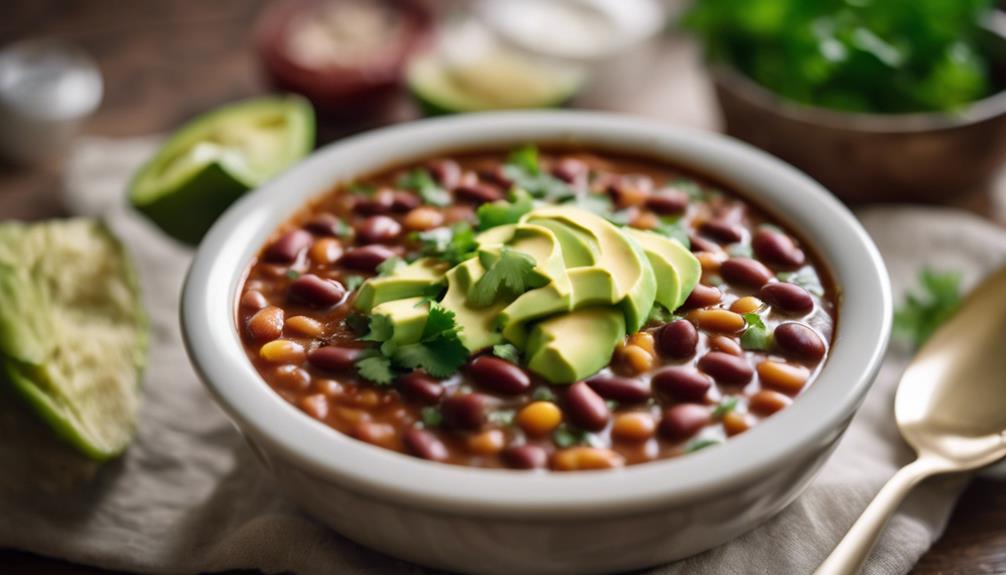
When considering savory options for vegetarian chili, you can explore recipes like:
- Bean and Lentil Chili
- Smoky Chipotle Black Bean Chili
- Spicy Quinoa Chili Variant
These variations offer diverse flavors and textures that can cater to different taste preferences.
Experimenting with these options can add a delightful twist to your chili repertoire.
Bean and Lentil Chili
For a hearty and flavorful vegetarian chili option, try incorporating a mix of beans and lentils in your recipe. Lentil varieties offer a range of flavors that can enhance your chili, from earthy green lentils to nutty brown lentils. Experiment with different types to discover your favorite flavor profiles.
When it comes to beans, their texture can greatly impact the overall feel of your chili. Consider cooking techniques like slow simmering for creamy beans or pressure cooking for a firmer bite. Here are some tips to elevate your bean and lentil chili:
- Mix red lentils for a smooth texture and quicker cooking time.
- Use black beans for a meaty texture and a robust flavor profile.
- Try kidney beans for a hearty addition that holds up well in chili.
- Incorporate pinto beans for a creamy consistency and mild taste.
- Experiment with chickpeas for a nutty flavor and a slightly firmer texture.
Smoky Chipotle Black Bean Chili
To enhance your vegetarian chili repertoire, explore the bold flavors of a Smoky Chipotle Black Bean Chili. This savory dish combines the hearty goodness of black beans with the smoky heat of chipotle peppers, creating a delicious and satisfying meal for any occasion.
When preparing this chili, pay attention to the bean texture, ensuring they're tender yet firm to the bite, adding a delightful contrast to the rich sauce. The chipotle smokiness infuses the dish with a deep, complex flavor that lingers on your palate, making each spoonful a delight to savor.
Here are some key points to contemplate when making this flavorful chili:
- Achieve the perfect bean texture by cooking them just right for a balance of tenderness and firmness.
- Embrace the chipotle smokiness by adjusting the amount of peppers to suit your spice preference.
- Allow the flavors to meld together by simmering the chili slowly for a rich and robust taste.
- Enhance the dish with toppings like creamy avocado, tangy lime, or fresh cilantro for added freshness.
- Experiment with different beans or legumes to create your unique twist on this classic chili recipe.
Spicy Quinoa Chili Variant
Discover a flavorful twist on vegetarian chili with the Spicy Quinoa Chili Variant, adding a protein-packed and satisfying element to your meatless chili repertoire. Quinoa benefits shine in this hearty dish, providing a complete source of plant-based protein and essential amino acids. When combined with the rich flavors of chili recipes, quinoa offers a wholesome and nutritious addition to your meal.
- Incorporating spiced beans enhances the complexity of flavors, creating a robust and aromatic chili experience.
- Sous vide techniques can elevate the texture and taste of the quinoa, ensuring a tender yet toothsome bite in every spoonful.
- The high fiber content in quinoa aids in digestion and promotes a feeling of fullness, making this chili variant a satisfying and wholesome choice.
- Quinoa's versatility allows it to absorb the delicious chili spices, infusing each grain with a burst of flavor that complements the overall dish.
- Adding quinoa to your chili repertoire introduces a new dimension of texture and taste, making this variant a delicious and nutritious option for your next meatless meal.
Enhancing Chili Flavor
To enhance the flavor of your vegetarian chili, focus on spice infusion techniques, ingredient pairing tips, and secrets for achieving a perfect flavor balance.
By mastering these key points, you can elevate the taste of your chili to new heights and impress your taste buds with a harmonious blend of flavors.
Experiment with different spices, ingredients, and proportions to create a chili that's uniquely delicious and satisfying.
Spice Infusion Techniques
Enhancing the flavor of your vegetarian chili can be achieved through various spice infusion techniques. Infusing flavors into your chili using sous vide benefits by allowing the spices to permeate the beans thoroughly. Sous vide cooking involves vacuum-sealing ingredients in a bag and cooking them in a water bath at a precise temperature, ensuring ideal flavor infusion.
To enhance the taste of your chili, consider creating a spice blend with cumin, paprika, chili powder, and other seasonings. Before adding the spices to your chili, you can sous vide them with the beans to intensify their flavors. By cooking the beans and spices together in a sealed bag, the seasonings will infuse deeply into the beans, resulting in a more robust and complex chili.
Experiment with different spice combinations and adjust the cooking times and temperatures to find the perfect infusion for your vegetarian chili. The sous vide method offers a unique way to elevate the taste of your chili by intensifying the flavors of the spices and beans.
Ingredient Pairing Tips
To elevate the flavor of your vegetarian chili further, consider strategic ingredient pairings that can enhance the overall taste profile. When aiming to create a robust and satisfying chili, incorporating flavorful seasonings like cumin, smoked paprika, and chili powder can add depth and warmth to the dish. These spices not only provide a rich aroma but also infuse the chili with a complex flavor profile that will keep you coming back for more.
In addition to traditional ingredients such as beans and tomatoes, exploring tasty alternatives like sweet potatoes, quinoa, or lentils can introduce new textures and flavors to your chili. Sweet potatoes bring a subtle sweetness that balances out the heat of the spices, while quinoa adds a nutty taste and hearty texture. Lentils, on the other hand, offer a protein-packed option that can make your chili more filling and satisfying.
Flavor Balance Secrets
Achieving the perfect balance of flavors in your vegetarian chili is crucial to creating a truly delicious and satisfying dish. To enhance the flavor profiles of your chili, consider experimenting with ingredient substitutions such as using smoked paprika for a deeper smoky taste or adding a touch of cocoa powder to elevate the richness. Cooking techniques like roasting vegetables before adding them to the chili can intensify their flavors, creating a more robust taste.
When focusing on flavor balance, don't forget about texture balance. To achieve a well-rounded chili, make sure that you have a mix of textures, such as tender beans, crunchy corn, and soft tomatoes. This variety adds interest to each bite and keeps your taste buds engaged throughout the meal.
Final Thoughts
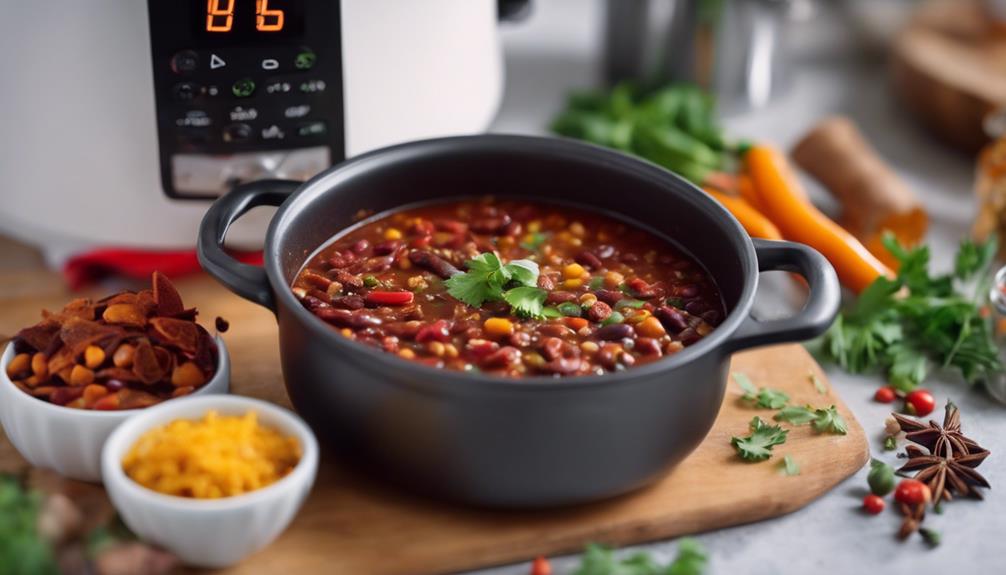
In conclusion, consider experimenting with different types of beans to customize the flavor profile of your vegetarian chili. Sous vide offers unique benefits by infusing the beans with spices, enhancing their taste while maintaining their texture. This method allows for a deep penetration of flavors, resulting in a more pronounced taste experience in every bite.
When it comes to texture contrasts, your ingredient choices play an essential role. Mixing beans with varying textures can add complexity to the chili, creating a more interesting mouthfeel. For instance, combining creamy black beans with firmer chickpeas can provide a delightful contrast that keeps each spoonful engaging.
Frequently Asked Questions
Can I Use a Slow Cooker Instead of a Sous Vide Machine?
Yes, you can use a slow cooker instead of a sous vide machine for this recipe. While slow cookers offer convenience and ease of use, sous vide guarantees precise temperature control for best flavor infusion and texture retention.
Are There Any Gluten-Free Options for Thickening the Chili?
To thicken chili without gluten, you can use cornstarch alternative like arrowroot powder, tapioca flour, or potato starch. These options work well and won't compromise the gluten-free nature of your dish. Try them out!
Can I Substitute the Beans With a Different Protein Source?
Yes, you can substitute the beans with meat alternatives like tofu, tempeh, or seitan for protein substitutions. These options can add a hearty texture and diverse flavors to your chili while providing a different source of protein.
How Can I Make the Chili Spicier Without Overpowering Other Flavors?
To heighten the spice level in your chili without overwhelming other flavors, try gradually adding small amounts of a hotter pepper like cayenne or chipotle. This method guarantees flavor balance and heat intensity for a harmonious taste.
Is There a Recommended Way to Store and Reheat Leftover Chili?
To store leftover chili, refrigerate it in an airtight container within two hours. When reheating, use the stovetop or microwave until piping hot. For freezing, cool chili completely, transfer to freezer-safe bags, and label with date for easy preservation.
Conclusion
To sum up, vegetarian chili with sous vide spiced beans offers a flavorful and hearty alternative to traditional meat-based chilis. By incorporating a variety of vegetables, beans, and spices, this dish provides a satisfying and nutritious meal for those looking to enjoy a meatless option.
Experimenting with different ingredients and seasonings can elevate the flavor profile of the chili, making it a versatile and customizable dish for any occasion. Consider trying this recipe for a delicious and satisfying meatless meal.
